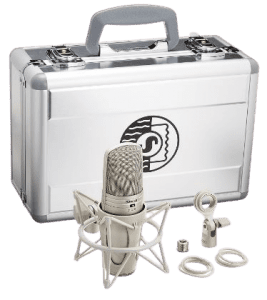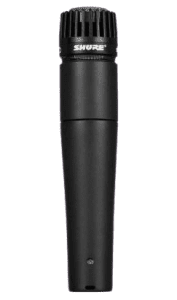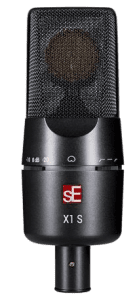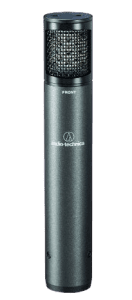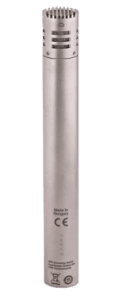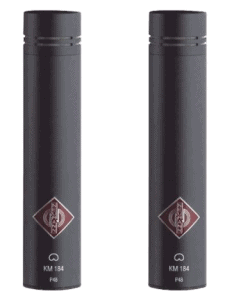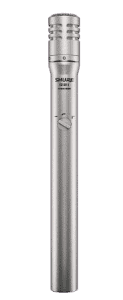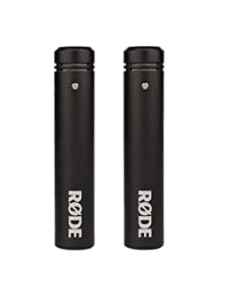An acoustic guitar is a staple of folk, pop, blues, rock, country, and various other music styles. There are different ways to shine the sound of your best acoustic guitar, but the microphone is the most effective of all.
Although, you can use any old microphone for recording, finding the right microphone for your acoustic guitar will make an enormous difference! The market is loaded with a variety of acoustic guitar microphones, which can cause a lot of confusion when you are trying to separate the wheat from the chaff.
Don’t worry, we are here to help you find the right one for your acoustic guitar. We have selected these 10 best microphones for acoustic guitar lovers based on the features, construction and customer experience.
Best Mics for Acoustic Guitar For 2022
1. LR Baggs Anthem-SL Acoustic Guitar Pickup and Microphone
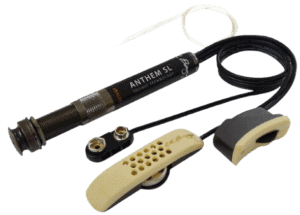
For those music lovers who are looking for a minimalist approach to controls, this best microphone for acoustic guitar offers the same groundbreaking studio mic’d fidelity, just like the Anthem that has a single volume control. It also has an endpin preamp that provides all-discrete circuitry to the genuine single.
The TRU.MIX of the microphone is premixed with the Element for best performance. Also, the mix is highly feedback-resistant. You can easily install it on the bridge plate along with the peel and stick adhesive. One of the best features of this microphone for an acoustic guitar is the noise-canceling microphone technology that eliminates external sounds for optimum performance. Additional features include a soundhole remote and battery bag.
But hey, don’t take our word for it. Listen to the video below to see for yourself!
Cons of the L.R Baggs Pickup and Microphone
My only complaints about the L.R Baggs pickup and microphone are that it is not the most easy to setup out of the microphones on this list and it can require quite a bit of adjustment depending on your guitar to setup correctly. Of course, there are lots of videos and tutorials online on how to set this microphone up, such as this one here.
Pros
- Comes With Endpin Preamp
- Award-Winning Cardioids Condenser
- Mic Level Control
- The Long Battery Life Of 170+ Hours
- Includes Element Pickup & TRU-MIC
Cons
- Tricky Installation For Hobbyists
Read More: Top 10 Best Acoustic Guitar Pickups For 2022
2. Shure KSM44A/SL Multi-Pattern Large dual-diaphragm Side-Address Condenser Studio Microphone
Offering various polar pattern options, including cardioids, omnidirectional, and bidirectional, this KSM44A is a premium microphone for acoustic Guitar. The Multi-pattern condenser offers excellent recording flexibility due to its compatibility with various polar pattern condensers. It comes with dual gold Mylar diaphragms for an excellent transient response, a preamplifier for transparency, and a subsonic filter.
To be honest, this is a premium choice for professional studio and stage performers. The best feature of this system is the achievement of sound reinforcement by Prethos Advanced Preamplifier Technology to offers supreme audio quality and performance. It also has 24 Karat gold-layered ultra-thin, low mass diaphragms to provide excellent frequency response.
The 3-position switchable low-frequency filter allows decreasing the unnecessary stand vibration noise and countering proximity effects. Other notable features include a subsonic filter, gold plated external and internal connections, and other premium electronic components.
Pros
- Prethos Advanced Preamplifier Technology
- Ultra-Thin Low Mass Diaphragms
- Switchable 15 Db Pad
- Integrated Three-Stage “Pop” Protection Grille
- 3-Position Switchable Low-Frequency Filter
Cons
- High Price
3. Shure SM57-LC Cardioid Dynamic Microphone
Another reliable microphone from Shure, the SM57 is one of the most versatile microphones available on the market. This best microphone features a cardioids pattern to focus on a single structure and reject the external sound from the pickup area. It can easily handle the highest tones of distortion, which makes it a perfect choice for recording high volume instruments.
This microphone is different from typical ones in various ways. With its clean and bright sound, the SM57-LC is an ideal choice for live sound reinforcement and recording. It comes with an effective cardioid pickup pattern, which eliminates the prime sound source while decreasing background noise.
Its excellent performance, reliability, and application diversity make this an excellent choice for recording guitars, drums, and woodwinds. Also, the pneumatic shock-mount system cuts down the handling noise. The best thing about SM57-LC is that it is incredibly durable under the heaviest use.
Pros
- Pneumatic Shock-Mount System
- Presidential Sound Quality
- Durable Construction
- Affordable Price
- An Excellent Choice For Studio And Liver Performance
Cons
- None
4. SE Electronics X1S Condenser Microphone
Offering robust lows with a smooth midrange, the X1S by sE is dominating the market. This microphone is an all-round performer having the ability to rack acoustic instruments and other vocals with detail and clarity. The X1 comes with a hand-built capsule, low-cut filter, and a 10bB pad.
This is basically the refined version of the sE X1, which was introduced in 2010. Featuring the highest dynamic range and SPL function along with other classic options, the X1 S has been improved in many ways but keeping the price within your range. The most appealing aspect of the microphone is the hand-made condenser capsule, well made and tuned by professional technicians with decades of experience.
Its internal design allows for enhanced sensitivity, dramatically improved SPL handling, and a massive reduction in self-noise. Also, the -10 dB and -20 dB switches offer a high dynamic range, which enables a variety of applications along with close-mic techniques. The selectable two low-cut filters eliminate the low-cut filters and also compensates for extra bass.
Pros
- Custom Design, Hand Crafted Capsule
- High-Performance Electronics
- Two Switchable Attenuation Pads And Low-Cut Filters
- Gold-Plated Xlr Connector
- Two Attenuations And Two Filter Switches
- High Dynamic Range And Spl Handling Low Self-Noise
Cons
- None
5. Audio-Technica ATM450 Cardioid Condenser Instrument Microphone
The Audio Technica ATM450 cardioid condenser features an innovative side-address stick design for different placement options and decreased obstructions. It comes with a microphone that is equipped with an integral 80 Hz hi-pass filter to provide comfortable switching from a flat frequency response into a low-end roll-off. This mid-range model sounds amazingly smooth for a small diaphragm condenser.
It has a brightened response that focuses on presence, slightly adding to its upper midrange and brilliance. One of the best usages of ATM450 is overheads. It also has a switchable 10 dB par to lower the sensitivity of the microphone and provide higher SPL capability for flexible use.
The flat frequency response of the condenser of the microphone makes it the choice for high SPLs and also for live and amplified acoustic instruments. This best microphone features a professional isolation clamp to offers safe mounting, comfortable positioning, and effective dampening for unnecessary mechanical noise.
Pros
- Unique Side-Address Sticks Design
- Reliable Performance For Professional Applications
- Cardioid Polar Pattern
- Isolation Clamp For Shock Protection
- Fixed-Charge Back Plate Permanently Polarized Condenser
Cons
- Difficult To Aim With The Windscreen On
6. AKG C 451 B Small-Diaphragm Condenser Microphone
AKG C 451 B is the new model in the C 451 series that was initially introduced in 1969. This best microphone for an acoustic guitar is a cardioid only design that comes with a permanently fixed capsule. The acoustics of the genuine cardioids capsule are molded and matched in the latest version to produce the distinctive overall rising frequency features.
Its transformer-less preamp utilizes surface mount technology, which makes it lighter but more rugged than the previous model. Also, 10 and 20 dB switchable pads are integrated into the AKG C 451 B. A selectable low-frequency option offers 12 dB/octave attenuation 75 or 150 Hz. Overall, this microphone is best known for its excellent sound by providing the highest quality and modern innovation in the music world.
The system provides extremely low distortion, less weight, and the highest reliability. The roadworthy design around its elegant handcrafted capsule, along with the low-noise preamp electronics, ensures excellent results even under tough conditions. Other notable features include windscreens, stereo bar, stand adapters, and carrying case.
Pros
- Handcrafted Fixed Capsule
- Rugged Construction
- Low-Noise Preamp Electronics
- Switchable 12-Db Roll-Off At 75 Or 150 Hz
- Switchable Pre-Attenuation Pad (10 Db & 20 Db)
- All-Metal Body
Cons
- None
7. Neumann KM 184 MT Stereo Set Condenser Microphone
This pencil style small-diaphragm condenser microphone by Neumann can rival the sensitivity of various diaphragm mics while maintaining high SPL handling. The KM 184 features a frequency range of 20Hz to 20 kHz, which is just like the large diaphragm mics that offer more detailed sound as compared to others. The manufacturer has focused on minimal off-axis coloration, which is an excellent feature for recording your best acoustic guitar.
The Mic has an excellent build quality and feel. The high input gain offers supremely, quiet operation. Users are happy with their experience when they used it for acoustic guitars, especially with the stereo mixing techniques. Also, it is an excellent choice for hi-hats, cymbals, orchestral instruments, and even vocal choirs.
The latest model of the microphone is also available in appealing stereo sets, with hyper-cardioid, cardioids, and Omnidirectional features. The 180 series consists of three compact miniature microphones that satisfy the demands of all typical studio applications.
Pros
- A Classic, High-Quality Miniature Microphone
- Versatile Applications
- Omni Directional
- Capsule With The Cardioid Pickup Pattern
- Exceptionally Clear Sound Reproduction Free Of Coloration
Cons
- High Price
8. Shure SM81-LC Cardioid Condenser Instrument Microphone
This cardioid condenser microphone by Shure is widely used in live sound, recording, and broadcast scenarios. It comes with a flat frequency response between 20 Hz and 20 kHz. The microphone offers a switchable low pass filter, which can be set to 6 dB/octave or 18 dM/octave. It also comes with many attractive features, including lockable -10 dB pads and SPL handling of 146 dB.
This best microphone for acoustic guitar sports a cardioid pattern that allows achieving a high gain level. Such polar pattern also has excellent off-axis rejection to help retaining isolation in the studio and live recordings. The SM81-LC provides exceptional durability that you can expect from reputable manufacturers.
The microphone is made of steel, which means you can comfortably use it for different conditions. It is also furnished with a swivel adapter, foam windscreen, attenuator-switch lock, and carrying case for safe storage. Overall, this is an excellent choice for live performances.
Pros
- Low Noise And High Output Clipping Level
- High Sound Pressure Level (SPL) Handling
- Selectable Low-Frequency Response
- Lockable -10 Db Attenuator Switch
- Phantom Powered
- Rugged And Reliable
Cons
- Mic Clip Has Plastic Covering
9. Rode M5-MP Matched Pair Cardioid Condenser Microphones
Whether you are recording a choir, an ambient sound, an orchestra, or a single instrument, these compact condenser microphones are an excellent choice for you. They will help you to make vibrant and bright recordings during live performances or in the studio. Commonly known as pencil mics, you can use this pair in a stereo array or individually. This best microphone for acoustic guitar has not more than one decibel of sensitivity difference between the couple. If you are looking for a perfect recording microphone for a string instrument, this is made for your needs.
The Rode M5 microphone pair comes with a directional pickup pattern to grab sound in a wide frequency range between 20Hz and 20 kHz. The best thing is they remove sounds to the sides and rear. Their self-noise is 19dB, which prevents them from recording with buzzing and humming. The output impedance of the mic is 200 ohms, which means they can work with longer cables and also record higher frequencies too.
Power options for the Rode MP5 are limited to 24 and 48-volts XLR connected phantom power. It also features a gold-plated output connecter for best conduction and precise signal transmission. The half-inch capsule also comes with a gold-plated membrane. Other notable features include windshields, one year warranty, and stand mounts.
Pros
- Ceramic Matte-Black Coating Over All-Metal Housing
- Comes With Premium Foiled Certificate
- Cardioid Polar Pattern
- 1-Year Warranty
- Includes Windshields And Stand Mounts
- Ultra-Low Noise
Cons
- Not For Large-Diaphragm
10. Shure MX202B/C Condenser Microphone
Featuring a compact design, this Shure MX202 Microflex Overhead Condenser Microphones can capture high-quality sound without any hassle. This is an excellent choice for theater stages, live performances, recordings, lecture halls, and more. It comes with three interchangeable condenser microphone cartridges that are attached to the flexible, four-inch gooseneck along with a 20-foot cable.
This small microphone has been manufactured to withstand extreme sound pressure. It reproduces sound with minimal electromagnetic hum or RF interface. Also, the new model of a microphone has interchangeable cardioids along with super-cardioid and omnidirectional condenser cartridges that can easily fit every model in the Microflex product line to improve convenience and consistent sound.
Available in white or black finishes, the microphone perfectly blends with most surroundings. The preamplifier gain can be decreased by 12 dB if needed. The wide frequency range with high sensitivity makes them best for recording and also for sound reinforcement applications. It’s well balanced, and the transformerless output offer improved immunity to noise over long cable runs.
Pros
- Supplied Stand-Mount Adapter For Portable Applications
- Wide Dynamic Range And Frequency Response
- RF Filtering
- Available In White Or Black Finish
- Interchangeable Cartridges
Cons
- Some Issues With Manufacturing
Buying Guide for Best Microphone for Acoustic Guitar
In order to find the best microphone on the market, you don’t need to be an expert in the field. All you need is to consider the following essential aspects before making a decision.
Dynamic VS Condenser
There are two different types of microphones for acoustic available on the market. Besides many similarities, there are some differences between the dynamic and condenser microphones.
Dynamic Microphones
Dynamic microphones are ideal for liver performance as they are more robust along with a durable capsule that can withstand harsh conditions.
Condenser Microphones
On the other hand, condenser microphones are slightly susceptible to damage and also more sensitive as compared to dynamic microphones. They can be best for home use or studio recordings. These microphones feature technology that needs them to be powered too. In simple words, you need to connect them to a desk or any audio interface for power. The best thing about condenser microphones is that they are sensitive, which means they can easily pick audio more clearly.
Commonly, the best microphone for an acoustic guitar is a condenser microphone. They are the right choice as they offer excellent clarity.
Diaphragm
Microphones have diaphragms in various sizes and shapes. Whether it is large or small, it has a significant impact on Mic’s performance.
A small diaphragm microphone is best for close up micing of instruments, and it is excellent for picking up detail. Remember, if the small diaphragm is a cardioid pattern, then it will reject most of the reverberation, and you will get the natural sound of the guitar. Also, these diaphragms are ideal for picking up bass frequencies.
On the other hand, large diaphragms have their own benefits. They offer more ambient and overall decent sound. Music lovers use them for vocals and acoustic instruments for their natural room.
Both diaphragms have their pros and cons. You should pick the right one that best suits your needs.
Polar Pattern
The capsule of your microphone has its own polar pickup pattern. In simple words, it’s like the range that they can hear tones. These are some handy diagrams out to help you better understand the trends.
The most popular one is cardioid, which can pick up tones directly in front of the mic. But, there are some different patterns. For instance, an omnidirectional pattern picks up sound from all around your microphone. You can use it to record acoustic guitar sounds.
Another popular pattern is a figure of 8, which rejects sound from the side of the mic’s input but may take it from the back and front. There are many mic techniques out on the market. Cardioid is the most important of all that you should consider. Some mics offer to switch the polar pattern, which is another significant advantage.
Frequency Response
A microphone picks up various frequencies in different ways. Some are best for recording acoustic guitar. For instance, AKG D112 is famous for recording bass.
Most microphones advertise the frequency response as 20 HZ to 20 kHz or similar. You need to pay attention to the graph of all frequencies, which shows exactly where the mic responds strongest to the frequencies.
USB Options
Most people don’t like USB microphones. A true audiophile purist will say that such mics don’t offer the proper clarity and may be hard to control. However, USB microphones may sometimes lack in detail, but they are very convenient.
They are ideal for home recording or making decent quality demos without any hassle. In fact, the plug and play compatibility is one of the most popular features in today’s modern world. You can also find USB models that can help to record onto a tablet or phone, making portability immensely easier.
Brand
Considering the brand may be the most important thing you can do before buying anything. In simple words, you can blindly trust any wristwatch from Rolex as compared to the ordinary brands on the market. Many microphone brands are famous for making the best product in the music industry. Popular brands such as Shure, SE, AKG, and others are renowned for quality and reliability. Some brands produce premium yet high price microphones that are intended for professional use. However, you should consider your needs before making a decision.
Conclusion
There are plenty of options available on the market, but not all of them are made for you. Remember, there is nothing like “perfect Mic,” so it is better to choose the best microphone that first your need and budget. From the best budget to an expensive microphone for acoustic guitar, we have shared the best microphones available on the market. Now, it’s your choice to select the right one. High priced microphones have premium features and excellent built qualities, whereas low priced ones have limited features with superb built quality.

